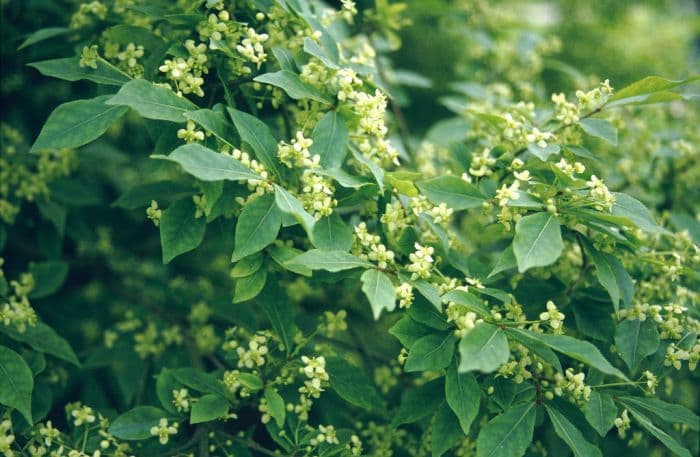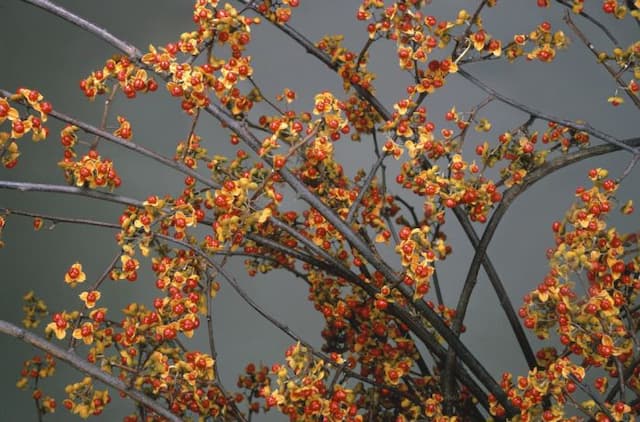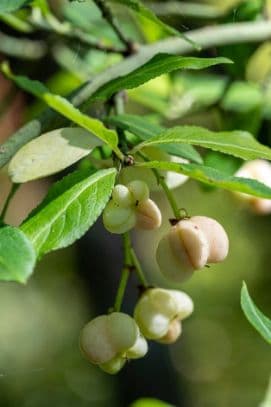Burning Bush Euonymus alatus 'Compactus'

ABOUT
The plant known as burning bush is known for being a visually striking ornamental shrub with a vibrant appeal. This plant has a natural rounded shape and is particularly noted for the fiery red foliage it displays in the fall. Its leaves are oval with distinctive ridged edges and a luscious green color during the warmer seasons. As autumn approaches, the green gives way to a deep, radiant red that has earned the plant its common name. Burning bush is also recognized for its interesting stem structure; the branches feature cork-like ridges or wings that add a unique textural aspect to the plant's appearance, making it a point of interest even when it is not in full color. In springtime, small yellow-green flowers can appear, but they are generally inconspicuous and overshadowed by the foliage. Later in the season, the plant may produce tiny fruits that ripen to a reddish-purple color, often attracting birds and wildlife. As a whole, the burning bush offers a showy display of color and texture, making it a popular choice for gardeners looking to add a splash of drama to a landscape.
About this plant
 Names
NamesFamily
Celastraceae
Synonyms
Burning Bush, Dwarf Burning Bush, Winged Euonymus, Winged Spindle, Compact Winged Spindle
Common names
Euonymus alatus 'Compactus'.
 Characteristics
CharacteristicsLife cycle
Perennials
Foliage type
Deciduous
Color of leaves
Green
Flower color
Greenish-yellow
Height
6-8 feet (1.8-2.4 meters)
Spread
6-8 feet (1.8-2.4 meters)
Plant type
Shrub
Hardiness zones
4-8
Native area
Asia
Benefits
 General Benefits
General Benefits- Ornamental Appeal: Burning Bush offers vibrant red autumn foliage, making it a popular choice for gardeners seeking seasonal color.
- Compact Growth: The 'Compactus' cultivar maintains a smaller size, ideal for limited spaces and garden borders.
- Drought Tolerance: Once established, this plant can withstand periods of dryness, requiring less frequent watering.
- Low Maintenance: Burning Bush is known for requiring minimal upkeep, making it suitable for busy gardeners or those seeking low-maintenance landscapes.
- Adaptability: It can thrive in a range of soil types and conditions, from acidic to alkaline and clay to sandy soils.
- Wildlife Habitat: Provides cover and food for birds and small animals, contributing to the local ecosystem's biodiversity.
- Year-round Interest: Aside from autumn, it offers interesting branch structure in winter, new green growth in spring, and dense foliage in summer.
- Erosion Control: The plant's root system can help stabilize soil on slopes, reducing the risk of erosion.
 Medical Properties
Medical PropertiesThis plant is not used for medical purposes.
 Air-purifying Qualities
Air-purifying QualitiesThis plant is not specifically known for air purifying qualities.
 Other Uses
Other Uses- Garden Sculpture: The dense, rounded shape of Compact Burning Bush makes it great for topiary or garden sculptures, allowing gardeners to shape it into various forms for artistic effect.
- Festive Decoration: Its bright red fall foliage can be used in autumnal wreaths or arrangements for festive seasonal decor.
- Learning Tool: Educators may use Compact Burning Bush to demonstrate plant physiology and the process of photosynthesis, as well as discuss invasive species management as it's considered invasive in some areas.
- Erosion Control: It can be used on slopes or banks for erosion control because its roots help to stabilize the soil.
- Wildlife Shelter: Although it does not provide significant food value, the dense branches can offer shelter and nesting sites for small birds and other wildlife.
- Privacy Screen: Planted in a row, Compact Burning Bush can act as a privacy screen or a natural fence, especially during the summer and fall months when foliage is thick.
- Photography Backdrop: Photographers might use the plant as a vivid backdrop for outdoor portrait photography in the autumn due to its striking coloration.
- Seasonal Indicator: The plant's predictable color change can be used by naturalists and educators as a phenological indicator of seasonal change.
- Winter Interest: The corky ridges and winged bark on mature branches of the Compact Burning Bush provide interesting textures in the winter garden when leaves have fallen.
- Theme Gardens: This shrub can be incorporated into theme gardens, such as a 'fire' themed garden, to represent the element with its fiery red leaves.
Interesting Facts
 Feng Shui
Feng ShuiThe Burning Bush is not used in Feng Shui practice.
 Zodiac Sign Compitability
Zodiac Sign CompitabilityThe Burning Bush is not used in astrology practice.
 Plant Symbolism
Plant Symbolism- Resilience: Euonymus alatus 'Compactus', commonly known as the Burning Bush, can adapt to a variety of soil conditions and can withstand environmental stressors, symbolizing the ability to persist and thrive through difficulties.
- Change/transformation: The Burning Bush is particularly known for its vivid red foliage in the fall. This dramatic change in color represents transformation and the beauty of change.
- Inspiration: The name "Burning Bush" is reminiscent of the biblical story of Moses and the burning bush. As such, it can symbolize inspiration or a spiritual awakening.
- Attention-grabbing: With its bright red leaves, the Burning Bush can stand out in any landscape, symbolizing qualities that attract notice or serve as a focal point.
 Water
WaterFor the Dwarf Burning Bush, ensure the soil is kept consistently moist but not waterlogged. During the growing season in spring and summer, water thoroughly once a week with about 1 to 1.5 gallons per plant. In the absence of rainfall, increase watering frequency to twice a week. During fall and winter, reduce watering to every other week unless there is sufficient rain. New plantings require more frequent watering, about two to three times per week, to establish roots.
 Light
LightThe Dwarf Burning Bush prefers full sun to partial shade. The ideal spot would provide at least 4 to 6 hours of direct sunlight each day, which ensures vibrant fall coloration. If grown in too much shade, the plant may not develop its characteristic bright red foliage in autumn.
 Temperature
TemperatureThe Dwarf Burning Bush is hardy and can tolerate a wide range of temperatures, surviving in zones 4-8. It can withstand minimum temperatures down to -30°F and is comfortable in typical summer highs up to 90°F. The ideal temperature range for these plants is between 60°F and 80°F for healthy growth.
 Pruning
PruningPrune the Dwarf Burning Bush to shape and maintain size, as well as to remove any dead or diseased branches. The best time for pruning is late winter to early spring before new growth starts. Pruning can be done annually or as needed to keep the plant within its desired bounds and to promote healthy, dense foliage.
 Cleaning
CleaningAs needed
 Soil
SoilThe Burning Bush prefers a well-draining soil mix with a slightly acidic to neutral pH, typically between 6.0 and 7.5. A mixture of loam, peat, and perlite or sand can provide the proper drainage and aeration this shrub requires.
 Repotting
RepottingThe Dwarf Burning Bush is not commonly repotted as it is a shrub; it should rather be planted in-ground or in a large outdoor container and transplanted only when necessary, typically every 3 to 5 years to refresh the soil.
 Humidity & Misting
Humidity & MistingThe Dwarf Burning Bush tolerates a wide range of humidity levels and does well in average outdoor conditions, with no specific humidity requirements necessary for its well-being.
 Suitable locations
Suitable locationsIndoor
Place in bright, indirect light; water when topsoil is dry.
Outdoor
Full sun to partial shade. Mulch root zone. Water deeply.
Hardiness zone
4-9 USDA
 Life cycle
Life cycleThe Burning Bush 'Compactus' (Euonymus alatus 'Compactus') begins its life cycle as a seed, which generally requires a period of cold stratification to break dormancy and germinate. Once conditions are favorable, typically in spring, the seedling emerges, developing roots and a shoot system. As the plant matures, it develops into a dense, compact shrub with a strong, woody stem structure and distinctive green foliage. During its growth, it undergoes a vegetative stage where it invests its energy in producing leaves, stems, and roots. The Burning Bush 'Compactus' reaches reproductive maturity and blooms in late spring to early summer, producing small, inconspicuous greenish flowers that are followed by red fruits, which can attract birds and other wildlife. Finally, the plant enters a period of senescence in old age where growth slows, and it may eventually die after many years, completing its life cycle.
 Propogation
PropogationPropogation time
Late winter-early spring
The most popular method of propagating the Burning Bush (Euonymus alatus 'Compactus') is through softwood cuttings. This is typically done in late spring to early summer, when the plant's new growth is still flexible and not yet woody. A cutting should be about 4 to 6 inches (10 to 15 centimeters) long, with several pairs of leaves. The bottom set of leaves is removed, and the cut end is often dipped in rooting hormone powder to encourage root development. The prepared cutting is then placed in a well-draining soil mix, ensuring that at least one node (where the leaves were removed) is buried, as roots will form from this point. The soil should be kept moist, and the cutting should be placed in a spot with indirect light until roots have established, which usually takes a few weeks. Once rooted, the new Burning Bush can be transplanted to a more permanent location.



![Spindle [Blondy]](/_next/image?url=https%3A%2F%2Fplants-admin.emdemapps.com%2Fimages%2Fplants%2F%2Fimages%2F604b642f54add.png&w=640&q=75)




